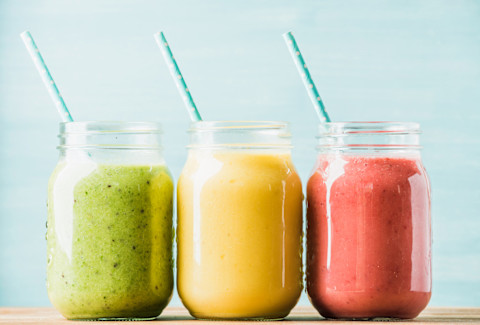These 7 Healthy Foods Are Actually Causing Candida Overgrowth
If you’ve clicked around any wellness websites (including this one!), you’ve likely come across some stuff about Candida and Candida overgrowth. So what is that, exactly, and what can you do about it? As a registered dietitian and integrative nutrition health coach, I help people figure out which foods and eating patterns support their goals and how to modify the behaviors that don’t. When it comes to preventing and treating a Candida overgrowth, diet plays an important part.
To put it very basically, Candida is a type of yeast. There are many varieties—about 20 shown to cause problems in humans. While some Candida is naturally present on the skin and in mucus membranes (like the mouth, intestines, and vagina), it can become a problem when you experience an overgrowth. When that happens, it can convert into a fungus and cause an infection1—candidiasis. This can be in one particular region of the body (as in thrush in the mouth or throat or a yeast infection) or systemic.
Because Candida plays a role in the digestion and absorption of nutrients, an overgrowth in the intestinal tract can lead to a variety of digestive disturbances as it breaks down the intestinal wall to release toxic by-products into your system—often called "leaky gut syndrome." In short, it seriously messes with your gut microbiome.1 Because symptoms like fatigue, digestive problems, brain fog, and depression can be related to a variety of conditions, systemic Candida infections can be hard to diagnose.
What causes Candida overgrowth?
Because Candida lives in the gut and plays a role in digestion, it’s no surprise that what we eat matters. Sugar is a main culprit because the yeast cells need sugar to grow and spread. A 2011 study2 that looked at one variety, called Candida albicans, showed that sugar supported both Candida cell growth and the conversion between the yeast and fungal forms. Because inflammation has also been shown3 to be an underlying cause, consuming a diet low in foods known to promote inflammation is key. To help protect and heal the gut, eating a diet to support a healthy gut microbiota is very important as well.
When it comes to healing candidiasis or taking a preventive approach, there are certain foods to avoid. You probably already know to avoid sugar in its more obvious forms like candy, cookies, pastries, and sugar-sweetened drinks, but you might be surprised at some of the other foods on this list. While consuming them isn’t a guarantee you’ll develop a problem, but if you’re trying to heal your gut and discourage the Candida from colonizing there, here’s some stuff to keep off the menu:
The Top 7 Healthy Foods Contributing to Candida:
1. Agave.

Agave may have a health halo around it, but this (yes, delicious) sweetener is still a very concentrated source of sugar (mostly in the form of fructose). Great news for hungry Candida cells, bad news for your body. Same story for honey, maple syrup, brown rice syrup, and other sweeteners—basically just sugar by other names.
2. Xylitol.

While they may not be sugar, artificial sweeteners can be just as bad. The damage? They wreak havoc on your digestive system and make it hard to maintain a healthy gut environment. Just do yourself a favor and skip it. On the list: aspartame, sucralose, xylitol, and sorbitol—and ideally, you should limit stevia as well.
3. Excessive amounts of fruit.

Wait, isn’t fruit healthy? While it’s true that fruit provides important vitamins, minerals, fiber, and antioxidants, the downside is that some fruits also contain a lot of sugar. A few to avoid on an anti-Candida diet: bananas, dates, grapes, mango, and dried fruit. Go for lower-sugar fruits like berries instead. Worried you’ll miss out on nutrients? Don’t—veggies (go for the non-starchy stuff) provide the same benefits without the sugar bomb.
4. Green juice.

Green juice is another example of something that sounds super-healthy but can undermine your good intentions. Many green juices are made with a lot of fruit, which hits the bloodstream super-quick. If you’re set on drinking your greens, try making a concoction without the fruit. Need a little something to offset the green? Add some ginger or lemon juice for a nice zing. You’ll also get an anti-inflammatory boost.
5. Grains.

Yes, grains provide essential vitamins and minerals, but those carbohydrates break down into sugar in the body, feeding the Candida. The gluten in grains like wheat, barley, and rye can also trigger inflammation in people who are sensitive and impair gut integrity. Especially if you’re actively working on healing your digestive system and treating a Candida infection, keep these off the menu. Need something to fill the void? Try cauliflower rice or zucchini noodles instead of their grain-based counterparts.
6. Wine.

The most obvious reason alcohol is on the "off-limits" list when it comes to Candida is the fact that it contains yeast. The sugar in wine and the carbohydrates in beer don’t help either. It’s also worth noting that alcohol is tough on the gastrointestinal system and can affect sleep and impair our immune system, making it harder to fight off Candida overgrowth in the first place.
7. Kombucha.

While fermented foods and beverages provide probiotic bacteria that support a healthy environment in the gut that may help protect against candidiasis in the long run, if you’re actively trying to treat an overgrowth, limit these items. The reason? When we have too much of even these beneficial bacteria, they can act as food for the Candida cells. While it’s not a lot, kombucha does contain a small amount of alcohol, so that’s another reason to limit it. Want something besides water to drink? Try sparkling water with some citrus or cucumber or infused with your favorite herbs. Ginger is my go-to, but have fun experimenting.
Watch out for these 10 signs you have Candida overgrowth, plus a first-person account of what having Candida is really like.
